Feature Interview with Mike Clayton
October, 2001
Mike Clayton turned Pro in 1981 and played in Europe until 1996 and still plays a little in Australia. Michael Clayton Golf Design was formed in 1995 with John Sloan and Bruce Grant and all three grew up playing and working on the Melbourne sandbelt. Mike also writes for the Melbourne Sunday Age Newspaper and Golf Australia Magazine.
1. How did you get interested in golf architecture?
From the beginning I was always just interested in golf – its history, the players, and the courses. To grow up in the city of Royal Melbourne and the rest of the sandbelt was a huge advantage, because it was always there to look at, to play, to study and to wonder why it all worked so well.
There is a big difference, however, between being interested in golf course architecture and actually getting to work in the business. Like every other player on the tour, your time is consumed by playing and only when I stopped, did I realise how much of the architectural side I had missed.
2. What projects are you currently working on?
We – John Sloan, Bruce Grant and I – have just finished a new course, our first, for the Amstel Club in Melbourne, and, we are looking forward to working with Tom Doak at Barnbougle Dunes. Otherwise, we are currently redesigning the entire back nine of the North Course at Peninsula CGC which has always been a poor design on a wonderful piece of land; some work at the Grange in Adelaide, where Greg Norman won his first tournament; and with the Australian Open at Victoria GC in the end of 2002 we are ‘encouraging’ them to undertake as much bunker restoration as possible. Doak refers to the extraordinary aerial photograph of the golf course in 1933 in his recent book about MacKenzie’s work in Australia, and that photo has been a wonderful guide.
3. When a professional golfer’s name is attached to a golf course project, do you feel that should mean that he has a certain level of involvement? If so, what is the minimal level of involvement that you think is acceptable?
We all know the attachment of a pro’s name to a project usually involves an exorbitant fee and in exchange it seems they largely become ghostwriters and real estate salesmen. If that is what they are, they can get away with the ‘one day, 6 hour’ involvement, which was apparently the extent of the involvement of one famous European Tour Project in Ireland. Of course it’s a joke, but if the project is successful who’s to argue.
For me, the joy comes from being involved with everything and, if clients have the courage to employ a young company with my name on it, they get me – for better or worse. Part of the fun is the relationships with the committee’s, the Superintendents, the contractors, the shapers, and, if you just stick your name on a job, turn up a few times without any emotional investment, it seems to me you miss a lot.
4. MacKenzie wasn’t a particularly good golfer; how does being an ace golfer help you design golf holes?
I don’t think being an ace golfer alone helps you design golf holes. It’s helpful understanding the thought process of a good player, but that’s not rocket science either and anyone who has played number 17 at Valderrama will know being an ace golfer can be of no help at all. If Pro’s can be accused of falling in to a trap it seems it is that they design courses around the way they personally play the game. Being able to think laterally is a real help in design, but often of no help when you’re playing, which is why good players do not necessarily become good designers.
5. Describe a particular hole that you have had a hand in designing and what you like so much about it.
We redesigned the 13th at Portsea GC, a club on the end of the Mornington Peninsula, built on some dramatic sandy land. It was a terrible short par 4 – 260 yards with the green hidden by trees, no bunkers, essentially no decision to make for a good player and a sloping fairway which meant if you couldn’t hit 180 yards, the ball would roll all the way across the slope into the trees. We pulled out the trees, built some seriously fearsome bunkers into the left side of the fairway and green and re-contoured the wide fairway, but gave the advantage to those who could lay up close to its right edge. The tee ought to go back a further 20 yards, but the club worry about the 17th green close by. From back there, the player is faced with a similar dilemma to the one posed by the 10th West at Royal Melbourne. I think it went from the worst hole on the golf course to one of the most interesting.
6. Why is the bunkering style so common in the Sand Belt not duplicated in other parts of the world?
I’ve no idea, because they are the most beautiful bunkers I’ve ever seen. Royal Melbourne have the best and Kingston Heath’s are wonderful, but every sandbelt course has awesome examples of the work that MacKenzie and Morcom encouraged so long ago. Maybe architects from other parts of the world have not spend the time to figure them out or how to build them, but Bruce Grant and his brother Graeme (Kingston Heath’s Superintendent 1983 – 1998), grew up caddying at Victoria then worked for Claude Crockford as soon as they left school. They understand it. Greame, the story goes, once asked another Australian architect why he didn’t build more bunkers in the style of the sandbelt and his answer was ‘it costs too much to do it the way you do’. There is no doubt though, Melbourne isn’t the only place in the world that this unique style would work.
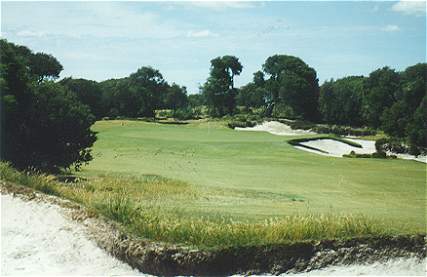
The bunkering on the 17th hole, West Course, Royal Melbourne
7. Golfers from a round the world seemed to be highly impressed by the conditioning of Metropolitan Golf Club during World Match Play tournament in January, 2001. How have the other sandbelt courses handled the pressure to compete maintenance wise with their nearby neighbor vs. balancing the cost against pursuing such an intense degree of maintenance?
It’s true, the fairways were incredible and Metropolitan is now renowned Australia wide for their ‘perfect fairways’. I’m a member there and I literally haven’t had anything less than a perfect lie in 8 years – but, I’m not sure that is such a great thing. The course plays 500 yards shorter than it used to because of the year round Couchgrass fairways, so from April to October it plays almost as it does in the Summer. It used to be an incredible long course in the Winter and it used to really change character with the seasons as Royal Melbourne still does.
If there is a problem with such perfection it is that people now look at ‘imperfect fairways’ and assume they are deficient in some way. Royal Melbourne doesn’t have ‘perfect fairways’ but they are perfect to play golf from. No other sandbelt club has increased its budget to Metropolitan’s levels in an attempt to achieve what was so revered by the Pro’s at the Matchplay.
The real issue is that people see the perfection of turf at Metropolitan and think that is what it is about. Quality greens and roughs, sensible tree management and good design get overlooked because ‘perfect fairways’ are easier to see and understand for the average player and they are what the committee’s get their pats on the back for.
8. How did you think the (other) Composite Course at Royal Melbourne played during the President’s Cup?
Royal Melbourne in 100-degree temperatures and wind – I read somewhere it didn’t blow during the Presidents Cup, but whoever said that wasn’t there the first two days – is a mystery and always has been. The undulation, the wind and the bounce make it really difficult to pull the right club and only truly great shots get near the flag when the course is in that mood. It’s exactly the opposite of the soft, predictable stuff we see on the US Tour, which is why the American’s got beaten. Parry, Norman, Nobilo, Turner, Elkington, Allenby and Appleby have seen Royal Melbourne in all its moods, and if you haven’t, it’s incredibly difficult to beat guys of that calibre.
The revised order of holes was much better for the purposes of the tournament, because it was always difficult to generate atmosphere on the old layout because the back nine holes covered such a huge piece of land. The new routing solved that problem but, there is no question the usual opening hole, a wonderful starting hole, proved to be a less than ideal 17th.
9. Kingston Heath has gone through a stunning transformation in the past 20 years and is now recognized amongst the world’s finest. Exactly what work has taken place there and who deserves the credit?
Kingston Heath pulled down a lot of old Mahogany Gum’s and Cypresses which opened it up, lowered the profile and they placed a deal of emphasis on replanting the low growing Heath’s that are so important at Royal Melbourne. Graeme Grant rebuilt all the greens, significantly altering 1, 6, 10, 13 and 18, all the tees, cut swales into the approaches of the par 5 7th and 14th greens and, he restored the original bunkers at 12 and 15 which transformed those holes. He added new bunkers down the left side of 13 which made it a much more difficult drive, and probably the only debatable thing he did was put a bunker in the middle of the 11th fairway. So Graeme was largely responsible for the transformation, but, he had a wonderful Captain in Bruce Langford-Jones and a relatively supportive membership who took heart every time there was a tournament and the Pro’s kept re-enforcing how much they loved the golf course.
10. Given how little time he spent in Australia, how much credit does MacKenzie deserve for the courses attributed to him?
He deserves the credit for rerouting of Royal Melbourne and the boldness of the concept of the whole course – with its huge fairways that place such an emphasis on driving the ball into the right place.
He deserves credit for explaining to Morcom exactly what he wanted and Morcom deserves the credit for doing it once he was gone. Whilst he only rebuilt one hole at Kingston Heath, it was the 15th which is a truly world class par 3 and essentially he bunkered the whole golf course. Alex Russell, his partner, built all of Yarra Yarra after he was gone and there are some wonderful holes there, including the par 3 11th which is probably the best par 3 in the country. There is some great stuff at Royal Adelaide, especially the 3rd and 14th, but they didn’t implement all of his plan. His influence over Morcom and Russell was incredibly important and whilst what he is directly responsible for is somewhat blurred, there is no question his influence has pervaded over all of the great courses in Australia.
11. What five courses do you most want to see that a) you never have and b) that you think would provide you some architectural ideas?
I’ve seen so little of America and really need to see all I can. Bruce (Grant) and I had planned a trip to coincide with Tom’s Renaissance Cup at Pacific Dunes to take in Cypress Point and San Francisco GC as well as Pacific Dunes, but unfortunately September 11 occurred.
I roomed for years in Europe with Rick Hartmann, the pro at Atlantic GC, and he keeps insisting I get to the National, Shinnocock and all the wonderful other course up there. But, how do you pick just 5? I guess I’d go with those two plus Pine Valley, Cypress Point and Crystal Downs because Tom speaks so highly of it.
12. Please list your favorite Australian Open sites from favorite to least favorite with a brief description of the course’s chief appeal.
- The Open goes to so few courses now for several reasons. We haven’t been to Royal Melbourne since 1991 and now the Heineken is there for 5 years we won’t get back there anytime soon, but it’s obviously the best.
- Kingston Heath’s chief appeal is how intricate and clever it is and it gives no advantage to the ‘smashers’ if they can’t think as well. The closing four holes have always proved extremely capable of sorting the contenders out at the end of an Open.
- Royal Adelaide. We played the Open here in 1998, which was the 1st time out of Melbourne and Sydney since 1974, but they ‘Carnoustied’ it and it was a controversial, high scoring, angry Open that didn’t work as well as it should have if the course had been set up sensibly. It’s such a good design it stands up pretty well on its own. Its chief appeal is the architect’s use of a piece of land that at first glance doesn’t seem that interesting, but, out of it came two extraordinary holes – numbers 3 and 14.
- Victoria. An often-used tournament course but the last Open here was 1981 and it’s finally going back there next year (2002). It’s an unusual routing with two par 5’s ending both nine’s. Whilst not in the class of the above three courses it always demands clever shotmaking because the wind is nearly always an influence and the greens get to be very firm and fast in tournaments and in fact, week to week, their consistently closer to tournament conditions than the rest of the sandbelt courses.
- Metropolitan. The atmosphere is always terrific because the back 9 holes work so well around each other. Personally I’m sad I never saw the original back 9 holes because the government built two schools on them 40 years ago. From the pictures you instinctively know they really lost something.
Then we have the Australian, Royal Sydney and the Lakes. I caddied on the Old Australian in the 1975 Open but Jack Nicklaus’ redesign turned out to be a much less appropriate golf course, considering how much wind they get there. The old course was a uniquely Australian golf course, but now it’s essentially a golf course one could easily find anywhere in America and one of the joys of travelling the world is finding golf courses unique to the countries they are in.
Trivia Question.
Tigers highest round as a Pro? 79, 1st round of the 1996 Open at the Australian.
Royal Sydney. Physically not that pretty but surrounded by the most expensive real estate in the country and some terrific holes, numbers 7, 8, 9 and 11. Because it is narrow and the greens are small it gets tough in the wind, especially number 15.
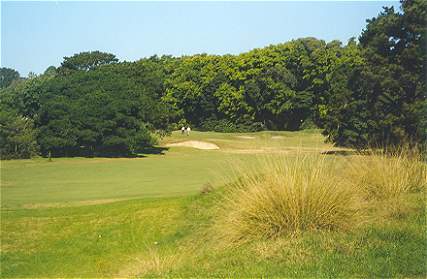
The 9th at Royal Sydney is a gem of a hole under 400 yards.
The Lakes. They say the original was great, but a freeway went through it in the late 60’s and Devlin / Von Hagge rebuilt it. There are some really good par fives (11 and 14 on the back around huge lakes and 16 is a fine hole), and the 10th in the wind is the hardest 350 yards in the game. Unfortunately it has gotten soft and the Kikuyu grass is very thick, so there isn’t any running game anymore. They can’t play the best course in Sydney, New South Wales Golf Club at La Perouse, because there is no effective practice fairway and it is tough to get crowds in and out.
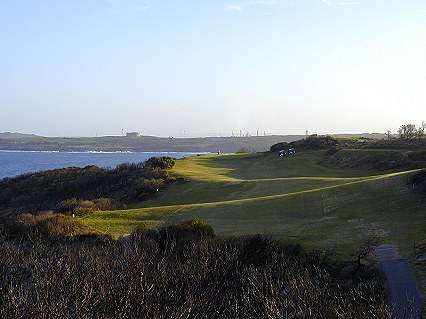
There is no place for spectators on the 14th at New South Wales.
13. How do you think the Australian Open courses compare in quality to the (British) Open courses?
St.Andrews, Muirfield, Turnberry, St.Georges, Carnoustie, Hoylake, Lytham, Birkdale, Troon. They are much different courses than ours. It’s difficult to compare but only Royal Melbourne, Kingston Heath, New South Wales and Royal Adelaide could be spoken as being comparable in terms of quality.
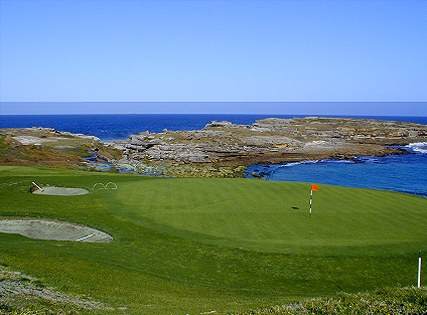
New South Wales Golf Club stacks up well against the very best.
14. What are your thoughts on Newcastle Golf Club in Stockon, New South Wales?
I’ve only played there twice, the last time a few years ago with the Captain and Ian Baker-Finch and we got him to cut some trees down which was a win. Wonderful land and a beautiful place to play – better than anything in Sydney, except New South Wales GC – I always remember those two par 4’s on the front (5 and 6) followed by the little par 3. Really underrated in Australia.
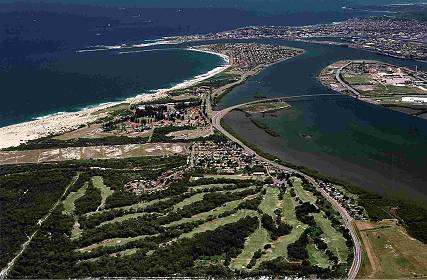
An aerial of Newcastle GC shows its proximity to the Pacific Ocean.

The tricky approach to the 5th green at Newcastle.
15. How would you compare Morfontaine to the great heathland courses around London?
I first played there against a French Amateur Team – 1980. Probably the most beautiful, peaceful place I’ve ever played. Every year we played the French Open at Chantilly, I would play my round and take a couple of caddies or other pro’s and go to Morfontaine to play. Is it better than Sunningdale or St.Georges Hill? I don’t know, but if you had to play there for the rest of your life you wouldn’t be disappointed and if that was the criteria it would be ahead of the two English courses. Incredible clubhouse – very French.
16. Where would you rank the East Course at Royal Melbourne amongst the sand belt courses?
The East Course is, I think, number 2 in Australia, but no-one else seems to agree. It is really underrated by many and they point to its not so dramatic holes, like number 8, yet I try and think of a poor hole and there simply isn’t one. A course with holes like 1, 2, 3, 4, 9, 10, 15, 16, 17, 18 has to be at least as good as Kingston Heath and ahead of the rest, especially since Commonwealth lost some holes it couldn’t afford to.
17. How do you think the Mornington Peninsula area will be percieved in twenty years time by the world golf cummunity? Do you think the Australian Open will ever be contested there?
Interesting. It depends upon the quality of the golf architecture and so far Norman’s Moonah course at the National is the best. Right now it’s in the balance because its real estate driven and name architect driven and we need to be really careful that great land isn’t wasted. The Australian Golf Union has a contract to play one Open – at least – at the new Moonah links course by Thomson-Wolveridge & Perret. Its 7500 yards, tough, windy and the Open is there in 2005.
The new courses so far are all big, long and difficult and it seems like everyone is having a tough time handling them in the wind. There is no doubt there needs to be a balance of sensible length courses that the average player can really enjoy and don’t tell me you can simply solve that problem by sending them 80 yards forward on every hole. Royal Melbourne and St. Andrews never have to do that.
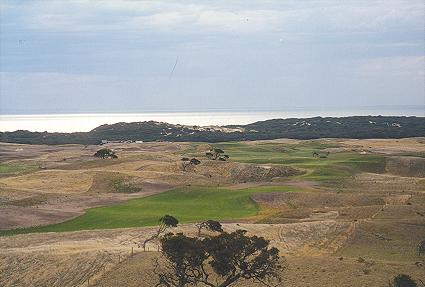
The Mornington Peninsula is blessed with rolling topography, sandy soil, and plenty of wind.
18. What time of year is optimal to come to Australia for golf?
March and April is the best time in Sydney, Melbourne and Adelaide and if you see the best in those three cities you won’t have missed much. However, even in the middle of winter, despite what the Queenslanders will tell you, Melbourne is a pretty nice place to play golf. Cheap too, the way our dollar is. In Victoria the best way to do it is to stay in the clubhouse at Barwon Heads, take the ferry from Queenscliff to Sorrento, stay in the clubhouse at Peninsula and do the Mornington Peninsula from there, then stay at Victoria and do the sandbelt. They all have great deals on bed, breakfast, dinner and golf.







